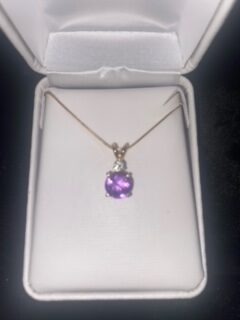Catherine the Great (Empress Catherine II of Russia, 1729–1796) had a penchant for amethyst and decked herself in amethyst necklaces, earrings and other ornaments.
Amethyst is the most prized member of the quartz family, thought to keep its wearers clear-headed and quick-witted.
The name “amethyst” derives from the Greek amethystos, which means “a remedy against drunkenness,” a benefit long ascribed to the purple birthstone. It was associated with Bacchus, the Roman god of wine, for this benefit and for its purple coloring.
Russia was the major source of amethyst until the 19th century, when large deposits were found in Brazil. Today, the most important sources of amethyst are in Africa and South America.
Amethyst and citrine are members of the same family and can sometimes grow together as ametrine – half purple and half yellow.
Amethyst is a 7 on the Mohs scale of hardness. This means that it is appropriate for daily use in rings and other jewelry, but over time it may show wear. Because amethyst is more susceptible to damage than harder gems such as rubies, sapphires and diamonds, you risk scratching your amethyst jewelry if you place it next to these harder stones!
Heat treatment can’t make pale amethyst darker, but it can lighten the color of very dark amethyst and make it more attractive. It can also remove unwanted brownish inclusions in some amethysts. Some amethyst turns yellow – to citrine – with heat treatment.

